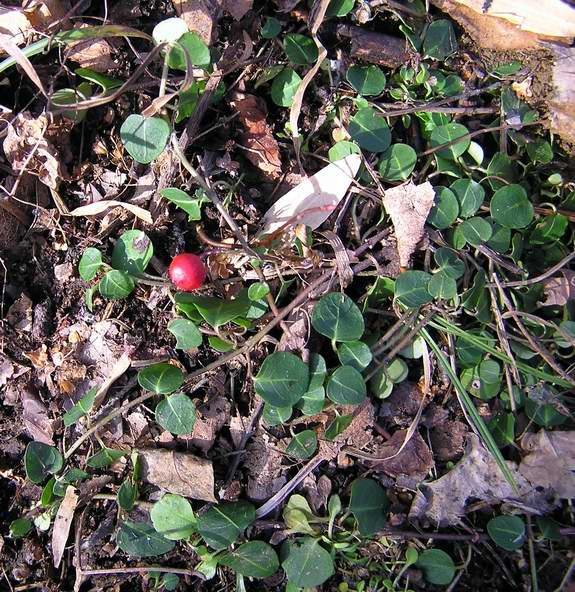|
Common
Name: Partridgeberry, squaw-vine, checkerberry, twinberry, deer berry, winter
clover, two-eyed berry, running-fox Scientific
Name: Mitchella
repens (Genus named for John
Mitchell, a physician who developed a treatment method for victims of
the 1742 Philadelphia yellow fever epidemic, repens
refers to its low creeping ground-cover growth) Partridgeberry is a diminutive evergreen ground-hugging vine that forms a dense mat from rooting stems. It has a spring-green color with bright red berries. Potpourri: The name squaw-vine derives from its use in Native American herbal medicine. Known as noon kie oo nah yeah in Mohawk, it was made into a tea that was used in the last several weeks of pregnancy to promote easy childbirth. It was once widely used by white women settlers and was listed as a drug in the 1927 U. S. National Formulary. It was removed in 1947 as parturition came to be a matter for hospitals and approved and tested drug therapies. The tea was also used to treat coughs and colds. The name twinberry is due to the peculiar manner in which the partridgeberry produces the fruit. Flowers are scattered along the individual stems in pairs that are joined at the base, sharing a single ovary. It therefore takes two flowers to make one "twinberry." However, the flowers are not identical. One flower has long stamens and a short pistil and the other flower has a long pistil and short stamens. No flower can fertilize itself (known as dimorphism) necessitating the cross fertilization of all flowers by insects. The berry has two small eyes or bumps that protrude from where the corollas were joined. The fruit of the partridgeberry is eaten ruffed grouse, raccoons, red fox (running-fox), and is estimated to make up about 3 per cent of the dry weight of the summer and fall diets of white tailed deer (deer berry). |
